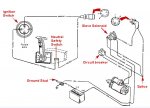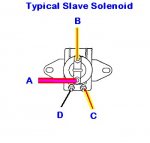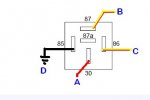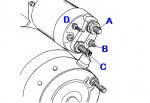Don S
Honorary Moderator Emeritus
- Joined
- Aug 31, 2004
- Messages
- 62,321
So you hit the ignition switch so you can go home and either nothing happens, or you hear a click from the engine, but the starter doesn't crank......... Now what ?
If you have a test light, you can find out in only a few minutes what the problem is. I like test lights because they are faster and easier to use than a meter. A meter will work fine for all the tests.

FIRST ON THE LIST:
Start by checking that you have a good battery that is fully charged. Make sure that all cables have clean tight connections on BOTH ends of the cables, and they are properly sized.
If you don't have this to start with, the rest of these tests are meaningless.
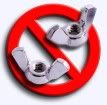
So, where do you start looking for your no start condition? That depends on what you hear. If you DO NOT hear a click, we will start at the ignition switch, if you hear a click, we will head for the engine compartment.
Let's say we have no click, and the shifter is in the neutral position and we have already tried wiggling the lever to be sure it's in neutral.
Grab your test light and head for the back of the instrument panel. Hook the clip to a good ground (usually on - terminal of a gauge, or the fuse panel).
Now, touch the light to the B terminal on the ignition switch ( big red or red/purple wire) the test light should light. Now move the test light to the S terminal with the yellow/red wire and have someone turn the key to the start position. The test light should light, if not, you need a new ignition switch.
Let's say it lit up, so the switch is good. While the problem could be the neutral safety switch, it's a real pain to get to in order to test it. So let's check to see if we have power going through the neutral safety switch.

Time to head for the engine compartment.
Now, locate the slave solenoid or relay, on the engine. Notice the 4 wires to it?

or for those with a Volvo that have a relay instead of a solenoid use this picture of the relay connector.

Hook up your test light again with the clip on a good ground. Now touch terminal C of the slave solenoid with your test light and have your helper turn the key to the start position again. The light should light up? If it did, touch your test light on terminal A, if it lights, hook your test light lead to it, and put the probe on terminal D (the ground) if it doesn't light, then you have a bad ground for the slave solenoid and without that ground the slave solenoid will not work.
If the test light did not light up, then the problem is 1 of 3 things either the connection at the main engine harness plug is bad, or you have a bad neutral safety switch or a bad connection between the ignition switch and the slave solenoid.
If you are at home, this isn't a problem and you can track the problem down. But if you are out on the water and the relay fails, what can you do? Simple. Use a test lead on the slave solenoid socket to jump between terminals A and B and the engine will crank. Make sure the ignition switch is in the run position and the engine will start.
Ok, lets say when you hit the switch you hear a click from the engine, but no cranking of the starter. Now what do you check.
Simple, back to the slave solenoid on the engine. Hook up your test light clip to a good ground and touch the tip to terminal A, if it lights, touch it to terminal B and have your helper hit the starter switch again. If you hear a click and the light does not come on, then the problem is a bad slave solenoid. If you are out and need to start the engine, you can disconnect the wires from terminals B and C and hook them together and you will be able to bypass the slave solenoid all together and it should work. If not, due to long wire runs, just jump between terminals A and B to crank the engine over.
If the light does come on, move on to the starter solenoid itself.

Touch terminal B on the starter solenoid itself, if the test light lights up, then you have a problem with the starter itself. Time to pull the starter and have it tested, repaired or replaced. If you are out on the water, you may be able to tap the solenoid (Gently, don't want to break things) while holding the switch to the start position and see if it will work. If not, you need a tow.
One other thing to keep in mind when checking with a test light or a meter either one. Check the terminal of the unit itself and also check the wire at the terminal. A corroded or loose wire end could also be the problem.
While this may sound like a lot of work, it only takes a few minutes to check things out.
These pictures are all from Mercruiser, mostly because they are available. OMC works the same, although their slave solenoid is a different kind, Volvo uses a relay instead of a solenoid, but again, it works the same way.
.
.
.
.
.
If you have a test light, you can find out in only a few minutes what the problem is. I like test lights because they are faster and easier to use than a meter. A meter will work fine for all the tests.
FIRST ON THE LIST:
Start by checking that you have a good battery that is fully charged. Make sure that all cables have clean tight connections on BOTH ends of the cables, and they are properly sized.
If you don't have this to start with, the rest of these tests are meaningless.

So, where do you start looking for your no start condition? That depends on what you hear. If you DO NOT hear a click, we will start at the ignition switch, if you hear a click, we will head for the engine compartment.
Let's say we have no click, and the shifter is in the neutral position and we have already tried wiggling the lever to be sure it's in neutral.
Grab your test light and head for the back of the instrument panel. Hook the clip to a good ground (usually on - terminal of a gauge, or the fuse panel).
Now, touch the light to the B terminal on the ignition switch ( big red or red/purple wire) the test light should light. Now move the test light to the S terminal with the yellow/red wire and have someone turn the key to the start position. The test light should light, if not, you need a new ignition switch.
Let's say it lit up, so the switch is good. While the problem could be the neutral safety switch, it's a real pain to get to in order to test it. So let's check to see if we have power going through the neutral safety switch.
Time to head for the engine compartment.
Now, locate the slave solenoid or relay, on the engine. Notice the 4 wires to it?
or for those with a Volvo that have a relay instead of a solenoid use this picture of the relay connector.
Hook up your test light again with the clip on a good ground. Now touch terminal C of the slave solenoid with your test light and have your helper turn the key to the start position again. The light should light up? If it did, touch your test light on terminal A, if it lights, hook your test light lead to it, and put the probe on terminal D (the ground) if it doesn't light, then you have a bad ground for the slave solenoid and without that ground the slave solenoid will not work.
If the test light did not light up, then the problem is 1 of 3 things either the connection at the main engine harness plug is bad, or you have a bad neutral safety switch or a bad connection between the ignition switch and the slave solenoid.
If you are at home, this isn't a problem and you can track the problem down. But if you are out on the water and the relay fails, what can you do? Simple. Use a test lead on the slave solenoid socket to jump between terminals A and B and the engine will crank. Make sure the ignition switch is in the run position and the engine will start.
Ok, lets say when you hit the switch you hear a click from the engine, but no cranking of the starter. Now what do you check.
Simple, back to the slave solenoid on the engine. Hook up your test light clip to a good ground and touch the tip to terminal A, if it lights, touch it to terminal B and have your helper hit the starter switch again. If you hear a click and the light does not come on, then the problem is a bad slave solenoid. If you are out and need to start the engine, you can disconnect the wires from terminals B and C and hook them together and you will be able to bypass the slave solenoid all together and it should work. If not, due to long wire runs, just jump between terminals A and B to crank the engine over.
If the light does come on, move on to the starter solenoid itself.
Touch terminal B on the starter solenoid itself, if the test light lights up, then you have a problem with the starter itself. Time to pull the starter and have it tested, repaired or replaced. If you are out on the water, you may be able to tap the solenoid (Gently, don't want to break things) while holding the switch to the start position and see if it will work. If not, you need a tow.
One other thing to keep in mind when checking with a test light or a meter either one. Check the terminal of the unit itself and also check the wire at the terminal. A corroded or loose wire end could also be the problem.
While this may sound like a lot of work, it only takes a few minutes to check things out.
These pictures are all from Mercruiser, mostly because they are available. OMC works the same, although their slave solenoid is a different kind, Volvo uses a relay instead of a solenoid, but again, it works the same way.
.
.
.
.
.
Attachments
Last edited:





















